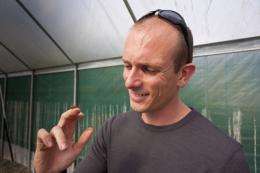Wiggling and waggling: Study sheds light on amazing bee brain

(PhysOrg.com) -- Their brains are tiny - about the size of sesame seeds - and yet the behaviour of the humble honey bee is so advanced it has scientists scratching their heads in disbelief.
New Australian research just published by Proceedings of the Royal Society of London has shown that the bee brain has the ability to estimate energy expenditure while foraging for pollen.
"To make honey, bees must gather more nectar from flowers than the energy spent collecting it, so in order to forage efficiently they need to know how much energy each foraging trip costs them," said Dr Andrew Barron, the author of the study and senior lecturer at Macquarie University.
Bees estimate distance visually, by watching the environment pass them during flight. Barron set out to determine whether bees also use this visual information to estimate their flight costs. His first step was to build two tunnels - one 10 metres long and one 20 metres long - and place feeders at the end of each to attract the bees. He then created an optical illusion to trick the bees into believing that the closest feeder was actually the furthest distance away.
"When bees return from a foraging expedition they let the other bees in the colony know where they have been and how good the nectar was by performing what's known as the waggle dance," Barron said. "The waggle dance performed by the bees in this study indicated that they were fooled by the illusion and believed that the feeder in the 10-metre tunnel was furthest away. Yet they could still tell somehow that they weren't using up as much energy by flying to that feeder - they favoured that one anyway and advised the other bees to do the same."
The results of the study showed the bees were definitely not using distance to estimate cost, but raised another question - how were they doing it?
"The bee brain has an incredibly simple make-up and yet it appears to possess an onboard calorimeter or stop-watch," Barron said. "Our study showed that bees can separately calculate distance travelled and foraging efficiency and communicate both independently using different elements of their dance language. Such mental agility explains bees' proficiency as nectar harvesters."
Barron said his aim was to work out how the bee brain makes these complex calculations.
"Through their dance behaviour we get a window into bee psychology and perception," he said. "Bees are beautiful little animals with great personalities - and we're only just getting a sense of how smart they really are."
Provided by Macquarie University



















